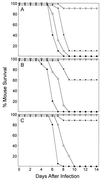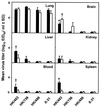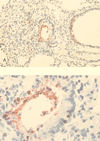A mouse model for the evaluation of pathogenesis and immunity to influenza A (H5N1) viruses isolated from humans
- PMID: 10364342
- PMCID: PMC112651
- DOI: 10.1128/JVI.73.7.5903-5911.1999
A mouse model for the evaluation of pathogenesis and immunity to influenza A (H5N1) viruses isolated from humans
Abstract
During 1997 in Hong Kong, 18 human cases of respiratory illness, including 6 fatalities, were caused by highly pathogenic avian influenza A (H5N1) viruses. Since H5 viruses had previously been isolated only from avian species, the outbreak raised questions about the ability of these viruses to cause severe disease and death in humans. To better understand the pathogenesis and immunity to these viruses, we have used the BALB/c mouse model. Four H5N1 viruses replicated equally well in the lungs of mice without prior adaptation but differed in lethality for mice. H5N1 viruses that were highly lethal for mice were detected in multiple organs, including the brain. This is the first demonstration of an influenza A virus that replicates systemically in a mammalian species and is neurotropic without prior adaptation. The mouse model was also used to evaluate a strategy of vaccination against the highly pathogenic avian H5N1 viruses, using an inactivated vaccine prepared from nonpathogenic A/Duck/Singapore-Q/F119-3/97 (H5N3) virus that was antigenically related to the human H5N1 viruses. Mice administered vaccine intramuscularly, with or without alum, were completely protected from lethal challenge with H5N1 virus. Protection from infection was also observed in 70% of animals administered vaccine alone and 100% of mice administered vaccine with alum. The protective effect of vaccination correlated with the level of virus-specific serum antibody. These results suggests a strategy of vaccine preparedness for rapid intervention in future influenza pandemics that uses antigenically related nonpathogenic viruses as vaccine candidates.
Figures





Similar articles
-
Pathogenesis of and immunity to avian influenza A H5 viruses.Biomed Pharmacother. 2000 May;54(4):178-87. doi: 10.1016/S0753-3322(00)89024-1. Biomed Pharmacother. 2000. PMID: 10872716
-
Avian influenza (H5N1) viruses isolated from humans in Asia in 2004 exhibit increased virulence in mammals.J Virol. 2005 Sep;79(18):11788-800. doi: 10.1128/JVI.79.18.11788-11800.2005. J Virol. 2005. PMID: 16140756 Free PMC article.
-
Safety and antigenicity of non-adjuvanted and MF59-adjuvanted influenza A/Duck/Singapore/97 (H5N3) vaccine: a randomised trial of two potential vaccines against H5N1 influenza.Lancet. 2001 Jun 16;357(9272):1937-43. doi: 10.1016/S0140-6736(00)05066-2. Lancet. 2001. PMID: 11425416 Clinical Trial.
-
Prepandemic influenza vaccine H5N1 (split virion, inactivated, adjuvanted) [Prepandrix]: a review of its use as an active immunization against influenza A subtype H5N1 virus.BioDrugs. 2008;22(5):279-92. doi: 10.2165/00063030-200822050-00001. BioDrugs. 2008. PMID: 18778110 Review.
-
Influenza viruses and the evolution of avian influenza virus H5N1.Int J Infect Dis. 2008 May;12(3):233-8. doi: 10.1016/j.ijid.2007.07.002. Epub 2007 Oct 2. Int J Infect Dis. 2008. PMID: 17913533 Free PMC article. Review.
Cited by
-
A novel M2e-multiple antigenic peptide providing heterologous protection in mice.J Vet Sci. 2016 Mar;17(1):71-8. doi: 10.4142/jvs.2016.17.1.71. Epub 2016 Mar 22. J Vet Sci. 2016. PMID: 27051342 Free PMC article.
-
Immunization with live virus vaccine protects highly susceptible DBA/2J mice from lethal influenza A H1N1 infection.Virol J. 2012 Sep 19;9:212. doi: 10.1186/1743-422X-9-212. Virol J. 2012. PMID: 22992381 Free PMC article.
-
Virulence network of interacting domains of influenza a and mouse proteins.Front Bioinform. 2023 Feb 17;3:1123993. doi: 10.3389/fbinf.2023.1123993. eCollection 2023. Front Bioinform. 2023. PMID: 36875146 Free PMC article.
-
Viral replication rate regulates clinical outcome and CD8 T cell responses during highly pathogenic H5N1 influenza virus infection in mice.PLoS Pathog. 2010 Oct 7;6(10):e1001139. doi: 10.1371/journal.ppat.1001139. PLoS Pathog. 2010. PMID: 20949022 Free PMC article.
-
Immunization of primates with a Newcastle disease virus-vectored vaccine via the respiratory tract induces a high titer of serum neutralizing antibodies against highly pathogenic avian influenza virus.J Virol. 2007 Nov;81(21):11560-8. doi: 10.1128/JVI.00713-07. Epub 2007 Aug 22. J Virol. 2007. PMID: 17715243 Free PMC article.
References
-
- Anonymous. Code of federal regulations. Washington, D. C: Office of the Federal Register, National Archives and Records Administration; 1997. Animals and animal products; pp. 683–684.
-
- Bender C, Hall H, Huang J, Klimov A, Cox N, Hay A, Gregory V, Cameron K, Lim W, Subbarao K. Characterization of the surface proteins of influenza A (H5N1) viruses isolated from humans in 1997–1998. Virology. 1999;254:115–123. - PubMed
-
- Bender, C. Personal communication.
-
- Centers for Disease Control and Prevention. Isolation of avian influenza A (H5N1) viruses from humans—Hong Kong, May–December. Morbid Mortal Weekly Rep. 1997;46:1204–1207. - PubMed
MeSH terms
Substances
LinkOut - more resources
Full Text Sources
Other Literature Sources
Medical
Molecular Biology Databases

